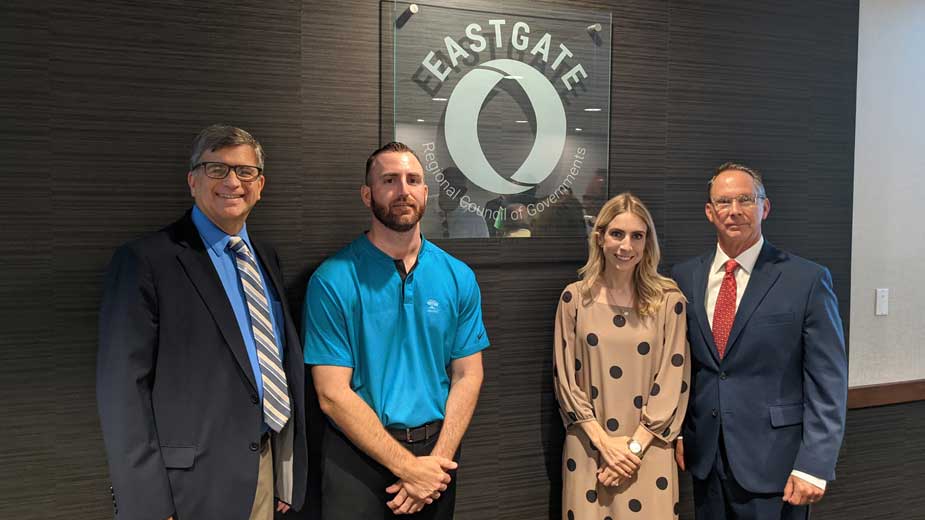Eastgate Study Envisions Lake-to-River Broadband Project
YOUNGSTOWN, Ohio – A newly completed feasibility study envisions the installation of nearly 100 miles of high-speed fiber line from state Route 11 at Lake Erie to the Ohio River, connecting more than 620,000 citizens throughout Ashtabula, Mahoning and Trumbull counties.
Local leaders gathered Tuesday at the Eastgate Council of Governments to hear the results of the 234-page Eastgate Broadband Feasibility Study, which outlined such a project. It could be completed as early as 2024 with an estimated price tag of $12 million to cover Ashtabula, Trumbull and Mahoning counties and another $15 million to expand into Columbiana County. Officials from Columbiana County will be contacted later to see if they are interested in joining the project.
Eastgate has been working on broadband access since late 2019. The study was conducted by Columbus-based IceMiller Whiteboard and MS Consultants from Youngstown.
The broadband project would expand online services for business, health, school and recreational usage, boosting economic growth and prosperity, and leading to more job opportunities and higher wages. It also would improve response times for public safety, as well as performance for government agencies.
Funding can be secured through state and federal grants and other means, said Lindsay Miller, partner at IceMiller Whiteboard. Among the items in the state’s new operating budget is $250 million for broadband internet expansion that would improve access for nearly a million Ohio residents who lack affordable, reliable access.
Other grants are available through the Residential Broadband Expansion Grant Program and the National Telecommunications and Information Administration Broadband Infrastructure Program, Miller said.
“Once we start to get some funding, we’re going to look to begin immediately,” said Mark Ragozine, Eastgate economic development planner.
That funding would come from a variety of federal and state sources. Determining how much a county or municipality would contribute is premature; no discussions have taken place on that matter, he said.
“We’ll take a look at everything to leverage those dollars to get the most bang for our buck,” Ragozine said.
The Eastgate study compiles information from businesses, schools, libraries and other infrastructures, creating a vision for all counties involved through this study, Miller said. Affordable housing, education, health care, libraries, philanthropy, transit and information technology centers all need digital inclusion.
“Can someone here tell me an industry that is not impacted by broadband?” Miller asked during her presentation. “If they can, it’ll blow my mind. I’ve never been able to get a response to this.”
The backbone fiber network would greatly increase capacity, even boosting manufacturing industries network capabilities, Ragozine said.
“It could significantly impact economic development. But this is a two-phase thing,” Ragozine said. “We want to make sure our residents have access, too.”
Along state Route 11 from Youngstown to Ashtabula, there is a significant dead zone of cellular service from northern Trumbull County to north of the U.S. Route 6 exit in Ashtabula County. There are also urban areas that lack reliable internet access.
“This is a key component to future development in our county,” said Ashtabula County Commissioner J.P. Ducro IV of the broadband project.
This project is also about retention, keeping a dwindling population in this portion of northeast and eastern Ohio.
“Anything we can do to boost that and retain some of our residents, keep our local, homegrown talent here, enhance businesses and attract new employers, that’s what we’re going to do,” Ragozine said.
“Businesses will benefit directly if they want to be connected, but also indirectly through high-speed internet with let’s say more access to quality workers,” said Steve Kristan, Eastgate broadband coordinator.
The study recommends the north to south fiber expansion along state Routes 7 and 11, supplemented with east to west connectivity along the Ohio Turnpike at state Routes 88 and 305 to ensure better connectivity in Ashtabula and Trumbull counties. Also recommended is a conduit along the vast part of U.S. Route 224 from Poland to Canfield.
There are also slated network expansions for “smart city” implementations and affordability for residents in Youngstown.
Enhanced and reliable internet to underserved rural and urban areas is important. One of the short-term goals is to get information out on the Emergency Broadband Benefit to see who qualifies, along with other assistance programs through companies like AT&T. Kristan said competition could lead to better pricing, which could be manifested in a couple of different ways.
“Anytime you have competition, it can have a positive impact on business as well as residents,” he said.
Making the connections can be tricky. Depending on the topography of the landscape, cable, wireless or other technologies may be used to connect the area. Different frequencies penetrate buildings, but they don’t go as far. There’s a balance between distance and connecting a building.
“You balance all of that out and you don’t want too much overlap,” Kristan said. “It’s almost like a science and an art.”
Pictured: At the discussion Tuesday were Steve Kristan, Eastgate broadband coordinator; Mark Ragozine, Eastgate economic development planner; Lindsay Miller, partner at IceMiller Whiteboard, which presented the Eastgate Regional Broadband Feasibility Study; and Jim Kinnick, executive director of Eastgate.
Copyright 2024 The Business Journal, Youngstown, Ohio.



